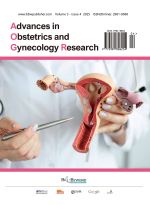Clinical Observation of the Effect of Sodium Ion Concentration on the Test Dose of Lidocaine in Patients Undergoing Epidural Block Cesarean Section
Abstract
Objective: To investigate the effect of changes in sodium ion concentration on the onset time of lidocaine in obstetric epidural block test doses. Methods: Eighty pregnant women scheduled for elective cesarean section, with no age or weight restrictions and ASA grade I or II, were selected. Lidocaine was diluted to two concentrations of 1% and 1.5% using normal saline (NS) and sterile water for injection (SW). The patients were randomly divided into four groups (n = 20): Group A (1% SW), Group B (1% NS), Group C (1.5% SW), and Group D (1.5% NS). A 3 mL test dose of epidural block was administered. The onset time, sensory and motor block levels, and adverse reactions were observed in each group. Results: The onset time was slowest in Group A (mean onset time 4.79 ± 0.65 minutes) and fastest in Group D (mean onset time 3.59 ± 0.61 minutes). Comparison between groups showed that the onset time was significantly shorter in Group B compared to Group A (P < 0.05), but there was no significant difference compared to Group C (P > 0.05). Group C had a faster onset time compared to Group A (P < 0.05), but a slower onset time compared to Group D, with a statistically significant difference. Group D had the fastest onset time, which was statistically significant compared to the other three groups. There were no significant differences in sensory and motor block levels or adverse reaction rates between the four groups (P > 0.05). Conclusion: Compared to sterile water for injection, diluting lidocaine with normal saline can shorten the onset time of the test dose. The 1.5% normal saline group had the shortest onset time, which is related to the increased sodium ion concentration in the solution, thereby reducing the onset time of lidocaine.
References
D’Angelo R, Berkebile B, Gerancher J, 1996, Prospective Examination of Epidural Catheter Insertion. Anesthesiology, 84(1): 88–93.
Luo X, Chen S, Zhang B, et al., 2010, Clinical Study of Ropivacaine Subarachnoid Block in Cesarean Section. Journal of Nanchang University (Medical Edition), 50(4): 88–91.
Brown W, Bell G, Lurie A, et al., 1975, Newborn Blood Levels of Lidocaine and Mepivacaine in the First Postnatal Day Following Maternal Epidural Anesthesia. Anesthesiology, 42(6): 698–707.
Birnbach D, Chestnut D, 1999, The Epidural Test Dose in Obstetric Practice: Has It Outlived Its Usefulness? Anesthesia and Analgesia, 88(5): 971–976.
Griffin R, Scott R, 1984, A Comparison Between the Middle and Paramedian Approaches to the Extradural Space. Anaesthesia, 39(6): 584–586.
Han C, Zhou Q, Qian Y, et al., 2010, Experience in Improving the Safety of Epidural Block. Shanghai Medical Journal, 33(10): 967–968.
Cesur M, Aliei H, Erdem A, et al., 2005, Administration of Local Anesthetic Through the Epidural Needle Before Catheter Insertion Improves the Quality of Anesthesia and Reduces Catheter-Related Complications. Anesthesia and Analgesia, 101(5): 1501–1505.
Mhyre J, Greenfield M, Kz L, et al., 2009, A Systematic Review of Randomized Controlled Trials That Evaluate Strategies to Avoid Epidural Vein Cannulation During Obstetric Epidural Catheter Placement. Anesthesia and Analgesia, 108(4): 1232–1242.
Harney D, Moran C, Whitty R, et al., 2005, Influence of Posture on the Incidence of Vein Cannulation During Epidural Catheter Placement. European Journal of Anaesthesiology, 22(2): 103–106.
Hadzic A, Vloka J, 2004, Peripheral Nerve Blocks: Principles and Practice. McGraw-Hill, New York: 1–720. ISBN: 0-07-140918-1.
Dhir S, Tureanu L, Bouzari A, et al., 2012, Reduction in Sodium Content of Local Anesthetics for Peripheral Nerve Blocks: A Comparative Evaluation of Saline with 5% Dextrose – A Randomized Controlled Double-Blind Study. Anesthesia and Analgesia, 114(6): 1359–1364.
Gambling D, Berkowitz J, Farrell T, et al., 2013, A Randomized Controlled Comparison of Epidural Analgesia and Combined Spinal-Epidural Analgesia in a Private Practice Setting: Pain Scores During First and Second Stages of Labor and at Delivery. Anesthesia and Analgesia, 116(3): 636–643.
Zhuang X, Zeng Y, Chen B, 2003, Modern Anesthesiology (3rd Edition). People’s Medical Publishing House, Beijing: 961–962.

